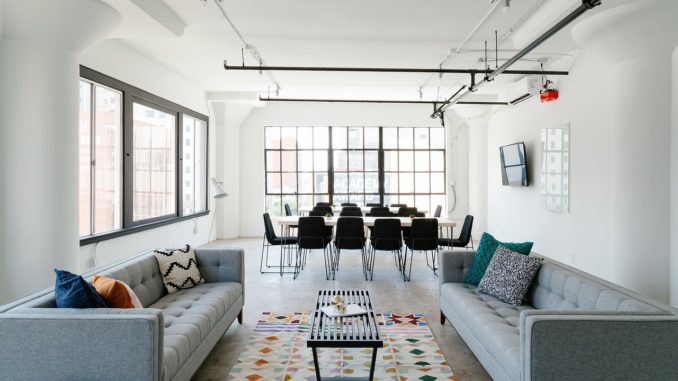
By Lloyd Coldrick, MD of Cobus
The modern office is evolving faster than ever as new design trends continually find themselves splashed across workplaces up and down the country.
In recent years, offices have transformed from stuffy, dim, boxed-off cubicle-style layouts to thriving hubs where collaboration is buzzing against a backdrop of the most trendy and functional interior designs.
Biophilic designs are ever-present and a revert back to industrial ‘bare bone’ materials continue to prove popular designs, while a rise in spaces that promote the wellbeing of the office user shows no signs of slowing.
2019 is no different, and if anything, has taken those design trends and moved into second gear.
Below, we’ve listed some of the most popular interior designs trends for 2019:
‘Living walls’
The trend for leafy living walls continues to rise. They are particularly loved by green-fingered urbanites and are a clever way of bringing the outdoors into the office environment.
Continued push for spaces that promote mental and physical well-being
Modern office designs are adapting to reflect the importance of employees’ health and happiness, and research shows that people with higher levels of well-being are more resistant to ill health, both physically and mentally.
Ergonomic office furniture is designed to stimulate a greater focus in perception, memory, reasoning and motor response.
Ergonomic chairs reduce stress on the spine, neck and hips by keeping the user upright, ergonomic keyboards increase typing speeds by reducing repetitive reaching and stretching and pivotal monitors allow employees to focus on their screens for longer periods of time, by reducing eye strains and headaches.
Relaxation/recreational breakout areas
With millennials predicted to make up half of the workforce by next year, new office design trends are emerging.
Office relaxation spaces where employees can unwind away from their working schedules is steadily gaining traction, as the lines between work/life balance become more blurred.
A versatile office environment
Nowadays, dynamic and agile spaces should be highly interactive and not be hampered by any physical or ergonomic constraints.
Re-arranged furniture can have a substantial positive impact on the output of employees. For instance, if furniture is comfortable and organic, employees will be able to work with minimal restrictions, and therefore be more productive.
Big rise in flexible working and coworking spaces
Although coworking spaces have been around for many years, it is only recently that they have come into the spotlight, mainly due to more providers entering the market to meet the needs of an increasingly fluid workforce.
The shift away from more traditional office spaces has aided the rising popularity of collaborative working environments.
More so than ever, coworking providers are seeking to create ‘a destination workplace’ – a space where people want to work.
Private workstations
Despite 2019 seeing a continued rise in flexible workplace layouts, there’s still a compelling reason not to drop private workstations in offices altogether.
While most businesses dislike the traditional dividers and booths of yesteryear, semi-enclosed settings are still proving popular as they let employees work with as little distraction as possible without being completely closed off from the rest of the office.
Increase in privacy storage
The recent enforcement of General Data Protection Regulation (GDPR) has altered the way in which employers store and secure sensitive data.
We can’t keep sensitive information visible on desks and computers in fear it could fall into the wrong hands. Safely securing data in appropriate storage such as folders and filing cabinets/drawers is crucial for all businesses in 2019.
Defurbishment
Defurbishment or ‘defurb’ is the process whereby buildings have been altered to expose the bare bones of their structure, including beams and brick or stone walls.
Incorporating natural materials like wood, slate and even water features encourage a natural, eco-friendlier feel. This style can be particularly effective in helping to attract a younger demographic in both new staff and clients.
Nowadays, people also want to know what goes into the products they use, and office furniture is no different. Using durable, honest materials that have been reclaimed or upcycled is a great way to demonstrate a business’s sustainable and environmental values, while creating an attractive brand identity that staff and customers/clients can buy into.
Human-centric designs
Human centric design gives designers a deeper understanding of creating living spaces that are more humanistic, holistic, and solve problems for people.
In a way, the challenge of the human centric design is even greater than a purely aesthetic approach, because designers must consider the user’s needs, aesthetic appeal and user friendliness into their vision.
Mixing aesthetics into a human centric design to create a unified whole with minimal artistic and ergonomic sacrifices is the ultimate challenge. The human centric design sends a message that the employees are of the utmost importance. Businesses have realised that a one-size-fits-all approach can’t be used. To design better, the human aspect of each individual company must be considered – it’s why a human centric approach is so important.
Overall, just like the pantone of the year; living coral, offices are increasingly getting bolder and more striking by adopting multifunctional designs that provide benefits to both the business and user.
Ultimately, we’re getting smarter in how we can merge varying designs to create a space that is aesthetically pleasing, health promoting, planet saving and profit boosting, all while having a degree of flexibility to ensure an inclusive space for all.
There’s no doubt the office of 2020 will bring new and pioneering design trends, but for now, the office of 2019 is leading the way in creating a working environment that allows the business, the environment and the staff to win.
Don’t forget to follow Dealer Support on Twitter!

Be the first to comment